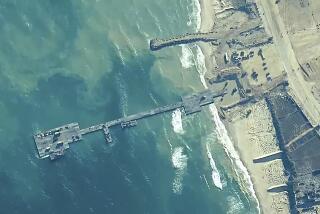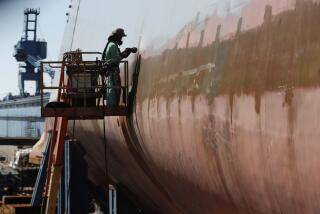U.S. Finds Flaws in Rapid Deployment
- Share via
WASHINGTON — With supply deliveries already slipping behind schedule and further delays ahead, the Pentagon has discovered flaws in the plans developed over more than a decade to assure rapid deployment of U.S. forces in a world crisis, military officials said Thursday.
The unexpected problems include engine failure on one of just eight elite U.S. fast-sea-lift ships that left a crucial cargo of M-1 tanks to be towed most of the way across the Atlantic, the officials said.
While insisting that the unprecedented operation has generally worked very well, officials conceded that the slower-than-promised deployment has frustrated commanders in Saudi Arabia and has taught a lesson about the speed at which the military can project its power.
“There have been certain parts of the deployment that have been a little slower than I would have liked or expected,” Gen. Colin L. Powell, chairman of the Joint Chiefs of Staff, said at a news conference in Saudi Arabia.
The shortcomings of supply expose weaknesses in aging military airlift and sea-lift capabilities and add to the difficulties encountered by U.S. troops seeking to set up operations in a hostile desert environment thousands of miles from home.
At the same time, what Powell called “some glitches” in the operation also represent the dissonance between plans and reality.
Most fundamentally, officials said, military planners repeatedly underestimated the amount of equipment needed by each unit, requiring sharp revisions in schedules as the Navy scrambled to arrange for the extra ships necessary to transport it.
Officials said in the case of the Army’s 24th Mechanized Division, based in Ft. Stewart, Ga., the “growth in cargo” meant that the unit required 10 ships when only seven had been assigned, setting off a chain reaction that set other shipments back.
Pentagon spokesman Bob Hall attributed the problems to the unwritten “Murphy’s law” that something will always go wrong, saying: “Murphy is out there, and Murphy is going to get you.”
Sources in Saudi Arabia say that despite troubles in the supply line, the U.S. contingent in the Middle East now numbers at least 145,000 troops, with another 50,000 scheduled to arrive in the next month.
Pentagon officials said most of the problems encountered so far have been minor and primarily involved movements of equipment. They conceded, however, that snafus at sea and in the air kept shipments of tanks and other crucial supplies from arriving when promised and forced postponement of some troop departures.
Gen. H. Norman Schwarzkopf, commander of U.S. forces in Saudi Arabia, estimated in an interview Thursday with the Associated Press that the delays have set the deployment back by eight days.
But other military officials warned that the need to perform overdue engine repairs on aging cargo planes will cause further setbacks before the U.S. buildup is complete. Hall said the move “fairly soon” from a “surge” to a “sustainment” pace would require C-5A, C-141 and other giant planes to halt operations for as long as a week for “preventive maintenance inspections.”
At the same time, Pentagon officials provided new details about the breakdown at sea last month of the Antares, one of the military’s eight fast-sea-lift ships.
The officials said a boiler failure meant that the ship had to be towed across much of the Atlantic, and its cargo--representing one-tenth of the M-1 tanks and other equipment for the 24th Mechanized Division--remains stuck in Spain weeks after it was scheduled to arrive in Saudi Arabia.
Another cargo ship, the Gulf Banker, has also experienced engine problems in the mid-Atlantic and may soon be taken under tow, officials said. And Air Force officials in Saudi Arabia said last-minute changes in plans left fighter planes separated from their crews by hundreds of miles, while a lack of preparedness forced some F-15 squadrons to cannibalize others for spare parts.
The shortcomings in the rapid deployment come after more than 10 years in which such a military operation has been a major preoccupation of planners.
The blueprint called on the military to mobilize a substantial stand-by force of civilian ships and aircraft to augment its own substantial sea-lift and airlift capacities. However, it also envisioned that any deployment would begin only after significant warning.
Officials said the current operation has challenged many such assumptions.
Congressional and outside analysts said the clearest lesson of the deployment is that the armed forces remain short of airlift and sea-lift capacity, according to congressional and outside analysts.
Lawrence Korb, a former assistant secretary of defense, noted that despite the massive defense buildup of the Reagan years, virtually no money was spent for additional cargo capacity.
But Korb and other experts joined the Pentagon in emphasizing that the military operation has been an overall success.
“When you look at the size of it all,” Powell said in Saudi Arabia, “. . . you’re bound to have glitches, and we have had glitches.”
Jehl reported from Washington and Healy from Saudi Arabia. Staff writers John M. Broder and David Lauter, in Washington, also contributed.
More to Read
Sign up for Essential California
The most important California stories and recommendations in your inbox every morning.
You may occasionally receive promotional content from the Los Angeles Times.














